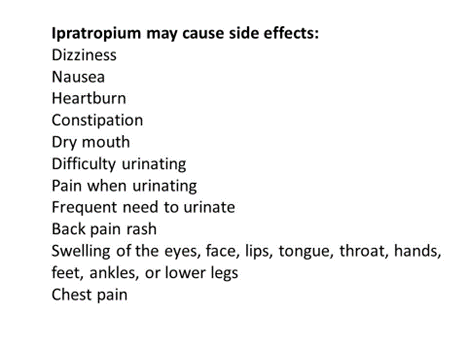The nurse is providing instruction about ipratropium (Atrovent) to a patient with COPD. Which is a common adverse effect that tends to resolve with therapy?
Dry mouth
Anxiety
Tachycardia
Urine retention
The Correct Answer is A
A. Dry mouth
Dry mouth is a common adverse effect of ipratropium (Atrovent) due to its anticholinergic properties. Anticholinergic medications can inhibit saliva production, leading to a sensation of dryness in the mouth. While uncomfortable, dry mouth tends to improve over time as the body adjusts to the medication. Patients can manage dry mouth by increasing fluid intake and practicing good oral hygiene.
B. Anxiety
Anxiety is not a common adverse effect of ipratropium (Atrovent). While some individuals may experience anxiety as a side effect of certain medications, it is not typically associated with ipratropium. If a patient experiences anxiety while taking ipratropium, it is essential to assess whether it may be related to other factors or medications and to consult a healthcare provider for appropriate management.
C. Tachycardia
Tachycardia (rapid heart rate) is not a common adverse effect of ipratropium (Atrovent). While ipratropium is an anticholinergic medication that can affect heart rate in some individuals, tachycardia is not typically reported as a common side effect. However, patients should be monitored for changes in heart rate and other cardiovascular effects while taking ipratropium, especially if they have pre-existing cardiac conditions.
D. Urine retention
Urinary retention is a potential adverse effect of ipratropium (Atrovent) due to its anticholinergic properties. Anticholinergic medications can relax the smooth muscle of the bladder, leading to difficulty emptying the bladder completely. However, urinary retention is less common with ipratropium compared to other anticholinergic medications, such as those used to treat overactive bladder. Patients experiencing urinary retention while taking ipratropium should consult their healthcare provider for further evaluation and management.

Nursing Test Bank
Naxlex Comprehensive Predictor Exams
Related Questions
Correct Answer is D
Explanation
A. Asking the provider to repeat another radiograph of the chest.
This option is not the most appropriate action in this scenario. While a chest radiograph may be useful in certain situations to assess for complications such as pneumothorax or pneumonia, it is not typically the first intervention for an asthma exacerbation with increased wheezing and decreased oxygen saturation. In this acute situation, the priority is to provide immediate treatment to alleviate the client's symptoms and improve oxygenation.
B. Increasing oxygen to maintain an oxygen saturation of 95% or greater in the client.
While maintaining adequate oxygenation is important, especially in a client with asthma exacerbation, it is not the first-line intervention in this scenario. Oxygen supplementation may be necessary, but the priority is to address the underlying bronchospasm causing the decreased oxygen saturation. Therefore, this option may be considered after initiating appropriate bronchodilator therapy.
C. Requesting the pharmacy to dispense 10 mL of dextromethorphan PO.
This option is not appropriate for managing an asthma exacerbation. Dextromethorphan is a cough suppressant and does not address the underlying bronchospasm characteristic of asthma exacerbations. In fact, suppressing cough may hinder the clearance of mucus and exacerbate respiratory distress. Therefore, this intervention is not indicated and may delay appropriate treatment.
D. Instructing respiratory therapy to administer a PRN albuterol aerosol.
This is the correct action in this scenario. Albuterol is a short-acting bronchodilator commonly used to relieve bronchospasm and improve airflow in clients experiencing asthma exacerbations. Administering albuterol via aerosolized inhalation helps to quickly deliver the medication directly to the airways, providing rapid relief of symptoms such as wheezing and improving oxygenation. Therefore, instructing respiratory therapy to administer a PRN albuterol aerosol is the most appropriate intervention to address the client's acute symptoms.
Correct Answer is ["A","C","E"]
Explanation
A. Inspiratory stridor
Inspiratory stridor is a high-pitched, musical sound heard during inspiration that indicates partial obstruction of the upper airway. It is a characteristic sign of airway obstruction and requires immediate attention.
B. Nausea
Nausea is not a common manifestation of airway obstruction. It may be associated with other conditions such as gastrointestinal issues or medication side effects but is not directly related to airway obstruction.
C. Retractions
Retractions refer to visible sinking of the skin between the ribs and above the clavicles during inspiration, which indicates increased effort to breathe. Retractions can occur in response to airway obstruction, as the body attempts to overcome the resistance to breathing.
D. Muscle tremors
Muscle tremors are not specific manifestations of airway obstruction. Tremors may occur due to various reasons such as anxiety, electrolyte imbalances, or neurological conditions but are not typically associated with airway obstruction.
E. Cyanosis
Cyanosis is a bluish discoloration of the skin and mucous membranes resulting from inadequate oxygenation of the blood. It can occur with airway obstruction as oxygen exchange is compromised. Cyanosis is a late sign of respiratory distress and requires immediate intervention.
Whether you are a student looking to ace your exams or a practicing nurse seeking to enhance your expertise , our nursing education contents will empower you with the confidence and competence to make a difference in the lives of patients and become a respected leader in the healthcare field.
Visit Naxlex, invest in your future and unlock endless possibilities with our unparalleled nursing education contents today
Report Wrong Answer on the Current Question
Do you disagree with the answer? If yes, what is your expected answer? Explain.
Kindly be descriptive with the issue you are facing.
